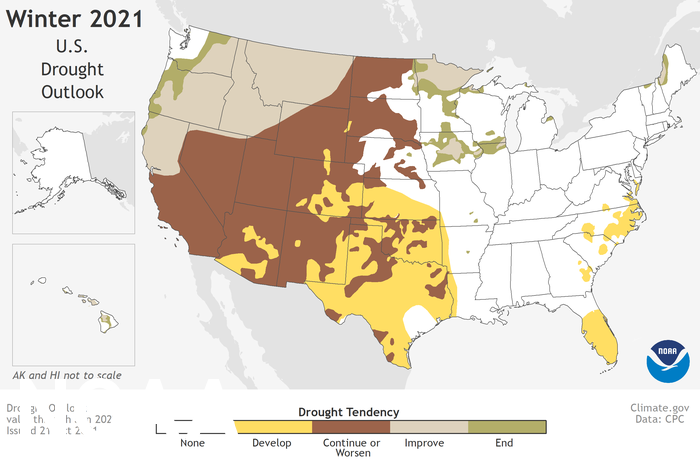NOAA releases winter weather predictions: Here’s what to expect

NOAA released its winter outlook for 2021-22. (NOAA Climate.gov based on NWS CPC data)
(NEXSTAR) – Climate experts at the National Oceanic and Atmospheric Administration have put together what they believe is the most likely weather pattern we’ll see when it comes to temperatures, rain, snow and La Niña this winter.
The agency released its winter outlook for the 2021-22 season, as La Niña conditions start to take hold for the second year straight.
Before we jump into the predictions, Jon Gottschalck, chief of NOAA’s operational prediction branch, reminds everyone this outlook is based on probability. “Other outcomes are possible, just less likely,” he said.
Here’s what NOAA is predicting for winter weather around the country.
Temperature
NOAA is forecasting a warmer than average winter for much of the country. The South and the Gulf Coast have the strongest probability of a warmer-than-usual winter. The Southwest, much of the Midwest and the Northeast can also expect a warmer winter.
The Pacific Northwest, Montana and the western half of the Dakotas are likely to see a colder-than-average winter.
Northern California, Wyoming and Minnesota look like they will see normal temperatures.

Precipitation (rain and snow)
The Pacific Northwest and Great Lakes region are most likely to see a wetter-than-average winter this year. The Northern Rockies, parts of New York, Ohio, Kentucky, West Virginia and Missouri may also see more precipitation.
The southern half of the country is looking at drier conditions, especially the Southwest, Florida and southern Georgia.
The rest of the country should expect an average amount of rain or snow.
This precipitation forecast has a lot do with La Niña, which has already started to settle in.

La Niña and Drought
For the second winter in a row, La Niña conditions are forecast to affect the country’s winter weather, said Gottschalck.
Gottschalck said this year’s La Niña looks like it will be a moderate (or upper-end moderate) La Niña pattern. This signals a wetter winter for parts of the Midwest and the Tennessee Valley, but drier conditions across the southern U.S.
Things look particularly bad for the drought in the Southwest, where drought conditions are forecast to worsen over the next few months.
However, things are looking up for the Pacific Northwest, said Brad Pugh, NOAA’s operational drought lead. The “strongest confidence for improving drought conditions” is found in the Pacific Northwest, Pugh said, where the next two weeks already look like they’ll bring a lot of rain.
California is split into two by a La Niña pattern, bringing more rain to Northern California and below-normal precipitation to Southern California – though it’s hard to predict exactly where that line will fall.

Drought isn’t as big of a concern this year in the South, Midwest and Northeast.










